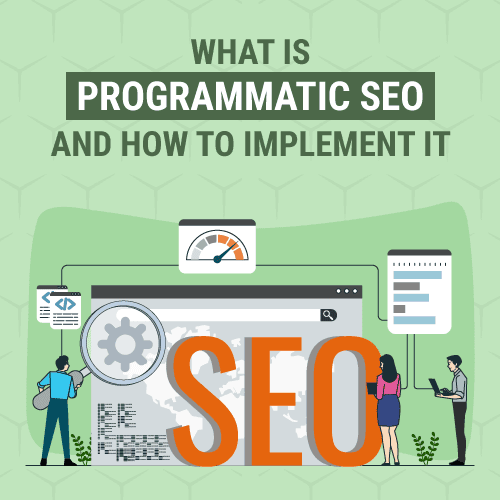Discover how programmatic SEO can revolutionize your digital marketing strategy by providing scalability and efficiency through automation techniques.

Image courtesy of via DALL-E 3
Table of Contents
Introduction to Programmatic SEO
Programmatic SEO is a powerful tool that helps websites improve their visibility on search engines like Google. In simple terms, Programmatic SEO uses automation to make the process of optimizing a website for search engines faster, more efficient, and scalable. Automation, in this context, refers to using technology to automatically handle repetitive tasks involved in SEO, allowing marketers and developers to focus on more strategic aspects of their website.
What is Programmatic SEO?
Programmatic SEO is a method of using automation to enhance a website’s search engine optimization. Instead of manually updating keywords, meta tags, and other elements on a website, Programmatic SEO allows for these tasks to be automated. This not only saves time but also ensures that SEO efforts are consistent and up-to-date.
Why is Programmatic SEO Important?
Programmatic SEO is crucial for websites looking to improve their search engine rankings and attract more organic traffic. By incorporating automation into SEO practices, websites can achieve scalability in their optimization efforts. This means that as the website grows and evolves, the SEO strategies can easily adapt and expand without requiring manual intervention for every change.
Understanding SEO
In order to understand Programmatic SEO, it’s crucial to first grasp the basics of SEO. SEO, which stands for Search Engine Optimization, is like a magic spell that helps websites appear higher on search engines like Google. When you search for something on Google, the websites that show up first are the ones with the best SEO.
What is SEO?
SEO is all about making your website more attractive to search engines so they can show it to people searching for things related to your content. By using specific keywords, creating quality content, and ensuring your website is easy to navigate, you can improve your SEO and climb the ranks on search engine results pages.
How Do Search Engines Work?
Search engines like Google have special robots called crawlers that crawl the web, looking at different websites and their content. These crawlers gather information and index it, which means they organize it like a library so they can quickly show the most relevant results when someone searches for something. Search engines then use algorithms to decide which websites are the most relevant and useful for a particular search query, ranking them accordingly.
How Automation Helps SEO
In the world of SEO, automation refers to using software or tools to streamline and simplify tasks that would otherwise be time-consuming if done manually. These tasks can range from analyzing website performance to generating reports and even optimizing content for search engines.

Image courtesy of capsicummediaworks.com via Google Images
SEO Tools for Automation
There are various tools available to assist in automating different aspects of SEO. Tools like SEMrush and Moz can help in keyword research and tracking rankings. Content management systems like WordPress offer plugins that automate technical SEO tasks like generating XML sitemaps and optimizing meta tags. Additionally, tools like Google Analytics can automate the tracking of website traffic and user behavior.
Benefits of Programmatic SEO
Programmatic SEO, with its automation features, helps marketers and developers save valuable time in managing and optimizing websites for search engines. Tasks that would otherwise require manual intervention, such as keyword research, content optimization, and performance tracking, can now be efficiently handled through automated processes. This frees up time for professionals to focus on strategic planning and creativity, improving overall productivity.
Scalability
One of the significant benefits of Programmatic SEO is its ability to scale up SEO efforts effectively. By automating repetitive tasks and streamlining processes, businesses can easily expand their SEO strategies across multiple campaigns and websites without the need for additional resources. This scalability ensures consistent and uniform optimization practices, resulting in improved search engine rankings and increased organic traffic over time.
Steps to Implement Programmatic SEO
In order to start with Programmatic SEO, it is crucial to define specific goals for your SEO strategy. These goals could include increasing website traffic, improving search engine rankings, or boosting online sales. By setting clear objectives, you can measure the success of your SEO efforts effectively.

Image courtesy of www.outranking.io via Google Images
Step 2: Choose the Right Tools
After establishing your SEO goals, the next step is to select the appropriate tools for automation. There are various SEO tools available in the market that can help streamline your SEO processes, such as keyword research tools, link building software, and analytics platforms. Make sure to choose tools that align with your objectives and budget.
Step 3: Monitor and Adjust
Once you have set your goals and chosen the right tools, it is essential to regularly monitor and adjust your SEO strategies. Keep track of key performance indicators (KPIs) such as website traffic, conversion rates, and keyword rankings. By analyzing data and making necessary adjustments, you can optimize your Programmatic SEO efforts for better results.
Common Tools Used in Programmatic SEO
When it comes to implementing Programmatic SEO, there are several tools and software available to assist marketers and developers in automating their SEO processes. Let’s take a closer look at two of the most common tools used in Programmatic SEO:
Tool 1: Google’s Search Console
Google’s Search Console is a free tool provided by Google that helps website owners monitor, maintain, and troubleshoot their site’s presence in Google search results. This tool provides valuable insights into how Google crawls and indexes your site, identifies any issues that may be affecting your site’s performance, and offers suggestions on how to improve your site’s visibility in search results.
Tool 2: Ahrefs
Ahrefs is a popular SEO tool that is widely used for backlink analysis, keyword research, competitor analysis, and website monitoring. With Ahrefs, you can track your website’s performance, analyze your competitors’ strategies, and identify opportunities to improve your site’s SEO. This tool provides comprehensive data and insights that can help you make informed decisions to optimize your site for better search engine rankings.
Challenges in Programmatic SEO
One of the challenges faced when implementing Programmatic SEO is the requirement for technical skills. Programmatic SEO often involves working with automation tools, scripts, and data analysis, which may be complex for beginners. Understanding how to set up automated processes, interpret data effectively, and troubleshooting technical issues are essential skills needed to successfully implement Programmatic SEO strategies.

Image courtesy of www.outranking.io via Google Images
Maintaining Accuracy
Another significant challenge in Programmatic SEO is maintaining accuracy in data analysis and implementation. Automation tools can streamline processes, but they also rely heavily on accurate data input. Any inaccuracies in data can lead to faulty insights and strategies, resulting in suboptimal SEO outcomes. Common pitfalls include relying on outdated data, misinterpreting analytics, or failing to update automation settings regularly.
Future of Programmatic SEO
In the future, AI (Artificial Intelligence) and machine learning will play a significant role in shaping Programmatic SEO. These technologies will enable automation to become even more sophisticated and efficient. AI algorithms can analyze large sets of data much faster than humans, allowing for quicker decision-making in SEO strategies. Machine learning algorithms can also adapt and improve over time, leading to more accurate and effective automated SEO processes.
Voice Search Optimization
Another important trend in the future of Programmatic SEO is the optimization for voice search. With the increasing popularity of virtual assistants like Siri, Alexa, and Google Assistant, more searches are being conducted using voice commands. This means that websites will need to optimize their content for natural language queries and conversational search phrases. Programmatic SEO will need to adapt to these changes by incorporating voice search optimization strategies to stay relevant in the evolving digital landscape.
Conclusion
In this guide, we’ve delved into the world of Programmatic SEO and the immense benefits it offers through automation and scalability. By understanding the basics of SEO and how search engines operate, we can see the importance of adopting automated tools to enhance our digital marketing strategies.

Image courtesy of seeders.agency via Google Images
Key Takeaways
Programmatic SEO is a game-changer in the digital marketing realm, offering time-saving solutions and the ability to scale up efforts effortlessly. By defining clear goals, selecting the right tools for automation, and consistently monitoring and adjusting strategies, businesses can leverage Programmatic SEO to drive significant results.
Tools like Google’s Search Console and Ahrefs play a pivotal role in streamlining SEO processes and achieving desired outcomes. However, challenges such as technical know-how and maintaining data accuracy need to be navigated effectively to maximize the potential of Programmatic SEO.
Looking ahead, the future of Programmatic SEO is ripe with exciting possibilities driven by AI, machine learning, and the growing importance of voice search optimization. By staying abreast of these trends and advancements, businesses can stay ahead of the curve and continue optimizing their online presence for success.
Want to turn these SEO insights into real results? Seorocket is an all-in-one AI SEO solution that uses the power of AI to analyze your competition and craft high-ranking content.
Seorocket offers a suite of powerful tools, including a Keyword Researcher to find the most profitable keywords, an AI Writer to generate unique and Google-friendly content, and an Automatic Publisher to schedule and publish your content directly to your website. Plus, you’ll get real-time performance tracking so you can see exactly what’s working and make adjustments as needed.
Stop just reading about SEO – take action with Seorocket and skyrocket your search rankings today. Sign up for a free trial and see the difference Seorocket can make for your website!
Frequently Asked Questions (FAQs)
What is Programmatic SEO?
Programmatic SEO is a method of automating and optimizing your website’s search engine optimization processes using tools and software. It helps in streamlining tasks and improving efficiency in managing SEO strategies.
Can beginners use Programmatic SEO?
Yes, beginners can certainly use Programmatic SEO. While some aspects may require a learning curve, there are user-friendly tools and resources available to help beginners get started with automating their SEO efforts.
What tools are needed?
Some basic tools needed for Programmatic SEO include tools for keyword research, on-page optimization, backlink analysis, and performance tracking. Popular tools like Google’s Search Console, Ahrefs, and SEMrush can be helpful in implementing Programmatic SEO effectively.







